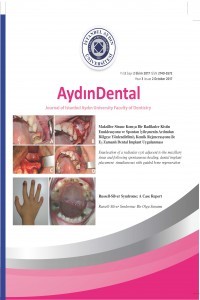Eroziv Lezyonlarin Direkt Kompozit Lamina Venerler ile Minimal İnvaziv Restorasyonu: Olgu
Giriş:Erozyon, abrazyon, abfraksiyon ve atrizyon nedeni ile ortaya çıkan çürüksüz servikal lezyonlar klinikte yaygın olarak görülmektedir. Diş erozyonu, bakteri etkisi içermeyen bir kimyasal iritan sebebi ile diş sert dokusunun kaybı olarak tanımlanmaktadır. Bu tip lezyonların zaman içerisinde ilerlemesi durumunda, dişlerde aşırı duyarlılık ve estetik problemler ortaya çıkmaktadır.Amaç: Bu olgu sunumunun amacı; üst çene santral dişlerde oluşan eroziv lezyonları direkt kompozit laminate venerler ile restore etmektir. Olgu Raporu: 34 yaşındaki kadın hasta estetik sebeplerden ötürü İstanbul Aydın Üniversitesi Diş Hekimliği Fakültesi Restoratif Diş Tedavisi Bölümü’ne başvurmuştur. Hastanın yapılan klinik muayenesi sonucunda; en fazla üst çene santal dişlerde olmak üzere eroziv defetler ve kesici kenarlarda da aşınmalar tespit edilmiştir. Hastadan alınan anamnez sonucunda, hastanın her hafta düzenli olarak limon tükettiği öğrenilmiştir. Üst çene santral dişlerin eroziv lezyonları, bağlayıcı ajan ve nano dolduruculu kompozit bir rezin materyali kullanılarak restore edilmiştir. Bitirme ve cila işlemleri yapılmıştır. Estetik restorasyonlardan sonra hastaya erozyona sebep olan faktörlerin elimine edilmesi konusunda bilgi verilmiştir. Pratik Uygulamalar: Klinik açıdan değerlendirildiğinde, minimal invaziv diş hekimliği ve reverzibilite ilkelerine dayanan direkt kompozit lamina venerler ile çürüksüz servikal lezyonlar estetik olarak restore edilebilirler.
Anahtar Kelimeler:
Dental erozyon, çürüksüz servikal lezyonlar, direkt kompozit restorasyon, dental lamina vener, minimal invaziv restorasyon
Minimally Invasive Restoration of Erosive Lesions With Direct Composite Laminate Veneers: A Case Report
Background: Non-carious cervical lesions (NCCLs) which may be caused by erosion, abrasion, abfraction and attrition are commonly observed in clinic practice. Dental erosion is defined as loss of dental hard tissue due to a chemical irritant that does not involve the influence of bacteria. In case of such lesions progress over time, teeth hypersensitivity and aesthetical problems arise. Objective: The purpose of this case report was to restore erosive lesions on maxillary central teeth with direct composite laminate veneers. Case Description: A 34 years old female patient presented to Istanbul Aydın University Dental Faculty Restorative Dentistry Department because of aesthetic reasons. After clinical examination; erosive defects mainly at the maxillary central teeth and worn incisal edges were diagnosed. As a result of the patient’s anamnesis, it was understood that, the patient consumes lemon regularly every week. The erosive lesions were restored with an adhesive system and a nanofill resin composite. Finishing and polishing procedures were performed immediately. After aesthetical restorations, information is given to the patient about the elimination of the factors which cause erosive lesions. Practical Implications: When clinically evaluated, direct composite laminate veneers are based on the principles of minimally invasive dentistry and reversibility that can be used for the rehabilitation of NCCLs aesthetically
Keywords:
Dental erosion, non-carious cervical lesions, direct composite restoration, dental laminate veneer, minimally invasive restoration,
___
- Levitch LC, Bader JD, Shugars DA, Heymann HO. Non-carious cervical lesions. J Dent 1994; 22:195-207.
- Pindborg JJ. Patholohy of Dental Hard Tissues. Munksgaard, Köpenhamn, Denmark, 1970.
- Ten Cate JM, Imfeld T. Dental erosion summary. Eur J Oral Sci 1996; 104(2(Pt 2)): 241-4.
- Lussi A. Erosive tooth wear- a multifactorial condition of growing concern and increasing knowledge. Monogr Oral Sci 2006; 20:1-8.
- Georgescu A, Iovan G, Stoleriu S, Topoliceanu C, Andrian S. Atomic force microscopy
- study regarding the influence of etching on affected and sclerotic dentine. Rom J Morphol
- Embryol 2010; 51: 299-302.
- Tuncer D, Çelik Ç, Yamanel K, Arhun N. 1 year clinical evaluation of microhybrid composites used in the restoration of non-carious cervical lesions. Oral Dent Health Manag 2014; 13(2): 366-71.
- Güldağ MU, Büyükkaplan UŞ, Ay ZY, Katırcı G. A multidisciplinary approach to dental erosion: A case report. Eur J Dent. 2008; 2(2):110-4.
- Passos VF, de Souza AM, Rodrigues LK, Bombonatti JC, Santiago SL. A conservative treatment approach using direct composite resins for anterior teeth eroded by lemon sucking. Gen Dent 2013; 61(5):e1-4.
- Perez Cdos R, Gonzalez MR, Prado NA, de Miranda MS, Macêdo Mde A, Fernandes BM. Restorations of noncarious cervical lesions: when, why, and how. Int J Dent. 2012; 2012: 687058.
- Belcheva A. Reconstruction of fractured permanent incisors in schoolchildren using laminate veneers (Review). J of IMAB 2008; 14(2): 101-4.
- ISSN: 2149-5572
- Yayın Aralığı: Yılda 3 Sayı
- Başlangıç: 2015
- Yayıncı: İstanbul Aydın Üniversitesi
Sayıdaki Diğer Makaleler
Endodontic Systems Working With Reciprocal Movements For Instrumentation of Root Canals
Eroziv Lezyonlarin Direkt Kompozit Lamina Venerler ile Minimal İnvaziv Restorasyonu: Olgu
Lokalize Dişeti Çekilmesine Multidisipliner Yaklaşım: Bir Olgu Sunumu
Burcu KARADUMAN, Cenker KOYUNCUOĞLU, Sevda ATALAY, Ece ÇALIŞKAN, Nurcan TEZCİ, Sabri Hasan MERİÇ
Yumuşak Dokunun Estetik Tedavi Planındaki Yeri
Rubberdam Clamp Ingestion During Root Canal Treatment: A
Ece ÇALIŞKAN, Hafiz Hande GÜRBÜZ, Rüştü DAĞLAROĞLU, Raif ERİŞEN
Diş Beyazlatma Ürünlerinin Dentin Mikrosertliğine Etkileri
Buket AYNA, Emrah AYNA, Sema ÇELENK, Behiye BOLGÜL, Ersin UYSAL
Rezin Nano Seramik Endokron: Post-Kor Destekli Kron Restorasyonlara Bir Alternatif
